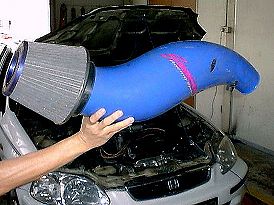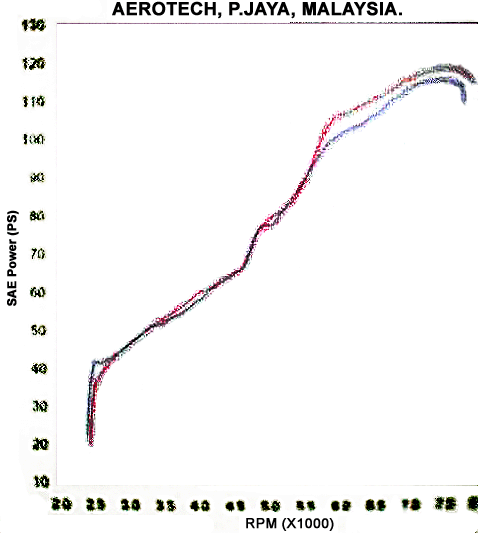Dyno-ing a Nearly Stock Civic SiR Auto

In 1996, Singapore along with a few other countries had the unique honour of receiving the EK4 Civic SiR into its domestic model range. This was the first time since its introduction that Civic type SiRs are available in the export market; the manual versions generating 170ps and automatic versions generating 155ps. Manual B16As now uses the 8200rpm red-line while the auto versions have the lower 7800rpm. All these are the same specs as the JDM versions. The SiRs were a great success in those countries, examples that have been dyno'ed all delivered exactly as their specs stated, proving that they are truly the same as the JDM version.

Automatic B16As have always been eternally popular. Using a relatively small capacity engine with a high loss automatic transmission can make a car sluggish. But the B16A is very high powered, and the auto versions has their power curve tweaked to suit the auto-box. Auto EK4s allowed owners to enjoy the convenience and ease of drive that an auto-box gives for town use but yet still having the benefit of a great reserve of power when situation demands.

The Singapore registered car in this article originally went to Aerotech for the very cost-effective HKS AFR package. As explained in the HKS section of Beyond Stock, HKS' AFR allows the engine's operating air-fuel ratio to be fine-tuned for local atmospheric conditions. The car arrived in practically stock condition, the only mod being an aftermarket Akimoto-style conical air-filter fitted via a unique 'trumpet' design intake tube to the throttle body. The original exhaust system was retained and everything else remains stock.

The Dyno Session
In its original form, the SiR auto dyno'ed at almost 111ps at the wheels. As stated, the current generation B16A for automatic transmissions are specified for 155ps at 7300rpm, max torque is 15.6kgm at 6500rpm. Honda's 4-speed automatic transmissions typically incurs losses of around 25%. Coupled with additional losses from the ancilliary devices like power steering pump, the alternator, etc, an auto-Honda typically sees a 30% reduction in power between the engine crank to the wheels. At 30% loss, ~111ps at the wheels will work out to around 158ps at the engine - almost exactly spot on to the stock power, taking into account the open element filter.
The owner was curious about the relative effectiveness of cotton based conical air-filters versus mushroom based foam filters. After some discussions, it was decided to replace the conical filter with the HKS Super-Power-Flow filter system and re-install the original rubber intake tube. Since the car was already in a dyno-session (purchased as part of the HKS AFR package), the owner wanted to see the dyno'ed power so as to make an informed decision on which to keep. The HKS system did give a nice dyno'ed power upgrade so it was kept (though unfortunately I did not manage to get the dyno chart). The HKS AFR was then installed and tuning of the car was done. AFR uses a single dial to adjust the MAP sensor signal to the ECU in order to modify the actual air-fuel ratio that the engine runs in. This adjustment is done over the whole rpm range. Detailed explanation of the operating principe of the AFR is located at Beyond Stock's Aftermarket Products area.
Tuning the AFR is ideally done by setting it on a dyno. Tuning usually starts from a setting of 6 and proceeds from there by checking the dyno'ed power for this and other settings. The setting with the highest power is usually retained though the smoothness of the power band and the engine note during the dyno-run is also considered. The Aerotech AFR tuning package also includes properly setting the engine's base ignition timing via the distributor, again using the dyno to check power levels.
Replacement of the air-filter system with the HKS Super-Power-Flow system and optimal setting of the AFR (final setting is at 5) allowed the car to dyno at around 116ps at the wheels. This is a big 5ps power gain at the wheels, equivalent to almost 8ps gain at the engine for almost 166ps at the flywheel. Gains was mostly made when VTEC switches the 'high-cams' into operation, with the largest power gain right after the 5500rpm switch-over point and big gains carried right into the red-line rpm.
Despite being nearly stock, this EK4 remains an interesting study because its dyno result gives us an invaluable reference value for the power of a stock (or nearly stock) automatic B16A as well as how effective a simple combination of filter and air-fuel regulator mod package will give for power upgrade. The dyno chart in this article was captured by using the macro mode of my digital camera and the original photo was out of focus because the camera was too near to the chart. Fortunately a member of my Honda Club was very handy with PhotoShop and he managed to restore the image to quite acceptable quality !
WongKN
© Temple of VTEC Asia
March 2001